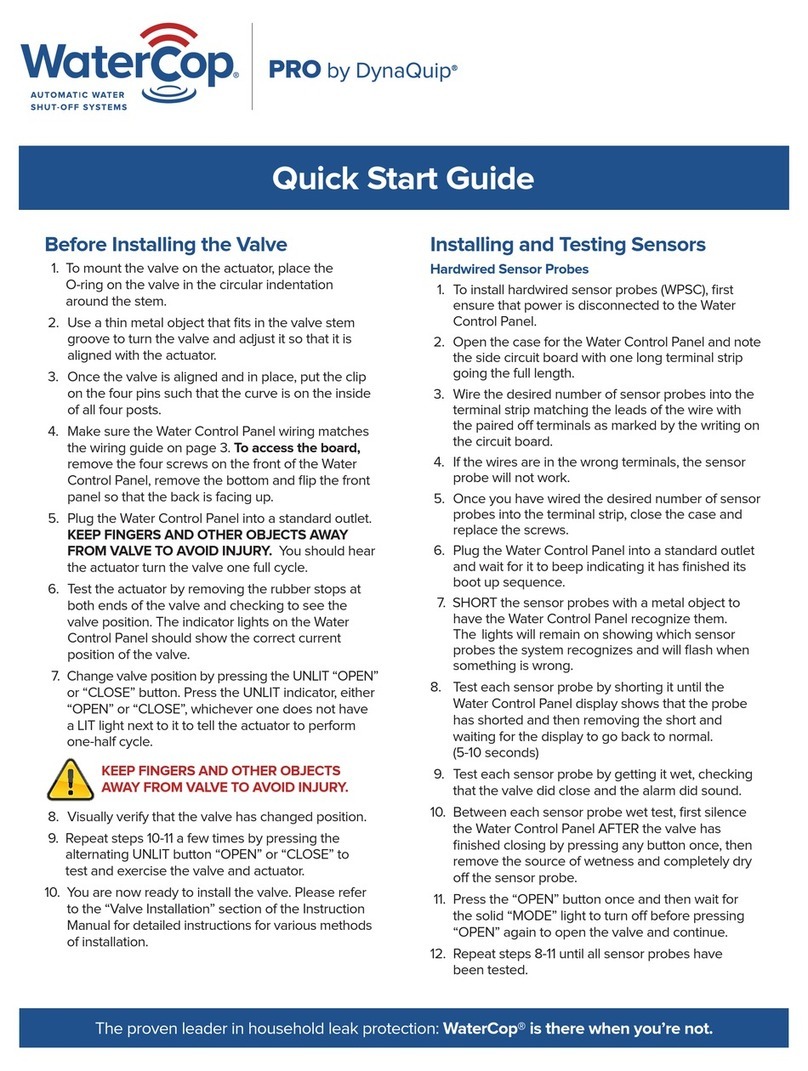
On the WaterCopPRO actuator press MODE twice (LCD will
display DEVICE ADD, press NEXT). Press CLOSE (LCD will
display DEVICE ADD, DEVICE # (next number).
On the Monitoring Station press CLOSE to add the
monitoring station. The WaterCopPRO actuator will turn to
a closed position (LCD will display WATERCOP NORMAL
WATERCOP WATER IS OFF).
Press OPEN on the WaterCopPRO actuator to complete
programming and reopen the valve. The LCD will display
WATERCOP NORMAL.
Pre-Installation Testing of WaterCopPRO
Although each unit is pre-tested at the factory, it is highly
recommended that the unit be tested prior to installation to
ensure proper operation in your home. Operating the valve
before connecting to the water line will not damage it.
Use caution!
• The valve closes with enough force to cut off a finger.
• Be extremely careful to keep fingers and other items out
of the valve.
Manually Test the Valve
To test your WaterCopPRO system, gently pull the safety
plugs out from each end of the valve. Check the position
of the valve by looking in either threaded end. In the open
position, you will be able to see through the valve; in the
closed position only the shiny surface of the ball will be
visible. Place the base of the housing on a sturdy surface,
as close as feasibly possible to the location where it will
be permanently installed. Plug the WaterCopPRO power
supply into a nearby 115 VAC outlet. As with all sensitive
electric equipment, the use of surge protection is highly
recommended. The valve position indicator lights should
now correspond to the actual position you noticed. Green
= Open. Red = Closed. Grasp both sides of the housing
(not the valve) with the valve pointing away from you for
safety. Being very careful not to have your fingers or other
objects near the valve openings, press the colored circle
just below the unlit indicator light. You will hear the motor
change the valve position. Again, look into the threaded end
of the valve to verify that the valve has changed position. If
it appears that the valve has not turned from one position
to the other, DO NOT try to reposition the valve yourself
by inserting any tool or fingers into the valve. Operate the
valve several more times from open to close, checking each
time for proper positioning. If you are experiencing trouble
getting the valve to open and shut, call the installation help
line listed on the back cover.
Manually Test the Flood Sensors
WaterCopPRO wireless sensors require power to operate.
Use either fresh AA batteries (not included) and/or a
WaterCopPRO Sensor AC Adaptor (sold separately) to
power. If both are used, batteries will provide back-up
power in the event AC is lost. Rechargeable batteries
are not recommended. To install batteries, remove the
battery cover located on the back of the sensor, and install
batteries in accordance with the (+ and –) placement guide.
Reinstall back plate.
Follow suggestions found in the section titled “Placement
of Flood Sensors” for recommendations where sensors
should be placed. Locate a wall near the area you choose
to monitor. Avoid high traffic areas where cord or sensor
could be stepped on or kicked. Mount transmitter at a
convenient location on the wall, 2’ to 3’ above the floor. This
will help avoid damage to the sensor and provide a strong
signal. Use fasteners included with the unit.
1. Following all safety precautions, make sure that the
WaterCopPRO is plugged in and the valve is in the open
position. Leave the WaterCopPRO near your main water
line, on a sturdy surface. It is important that anyone who
will be near the valve is aware of the safety precautions,
and does not insert any object into the valve, or handle
the valve during the test.
2. At one of the locations you have chosen to monitor, drop
the sensor probe (not the mounted transmitter) into a
cup of water. Hold until you hear the sensor transmit a
signal to the WaterCopPRO (about 5 seconds). This test
simulates a leak, and lets you check for interference
between the sensor and the WaterCopPRO.
3. Take the sensor out of the water and carefully dry off the
sensor and prongs.
4. Go back to your WaterCopPRO and verify that the valve
has closed (the red indicator light will be lit). The display
will indicate which sensor activated the valve.
5. Keep all objects away from the valve, reset the
WaterCopPRO by pushing the OPEN button.
6. Repeat steps 2 through 5 until you have tested each
sensor in the locations you wish to monitor.
Troubleshooting
• If the flood sensor does not close the valve, check that
the sensor is powered with correctly installed batteries
and/or AC adaptor. Repeat test.
• If the batteries have power and the wireless sensor
still does not make the valve close, physically remove it
from its installed location and place it next to the Water
Control Panel. Repeat test. If the sensor operates
properly when it is closer to the Water Control Panel,
but not when it is installed at its remote location,
try moving the sensor to a different position or try a
different wireless sensor. Some possible causes of
signal reduction are steel construction, foil backed
insulation or other large metallic barriers. You may
also use a range enhancing repeater (WPR – sold
separately) to extend the effective range of the
wireless signals.
Installation of Flood Sensor
Once testing is complete, finish installation of the flood
sensors by unwinding the cord and placing the sensor
probe on the floor at the lowest point (where water would
naturally collect) in the area to be monitored. Be sure that
the sensor probe is placed FLAT on the floor so water can
be detected as soon as it begins to accumulate. The sensor
probe may be secured to the floor with screws or adhesive
tape, taking care that the metal probes are not covered.
6


























